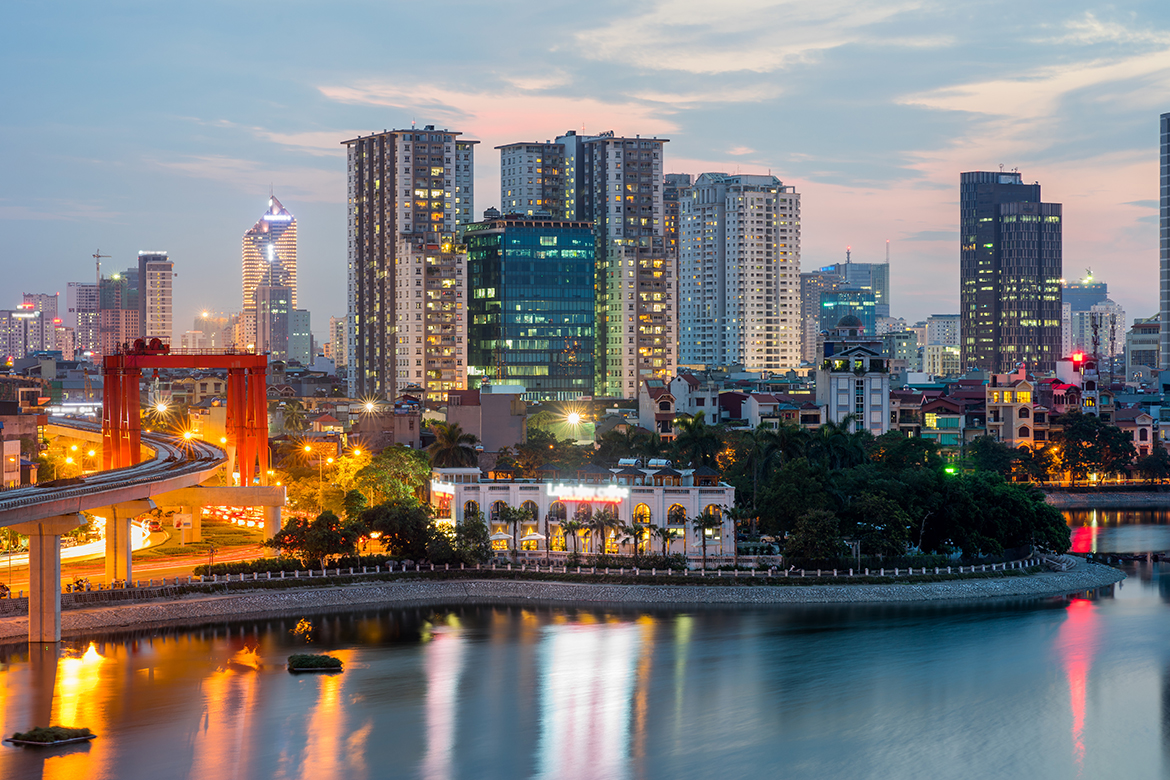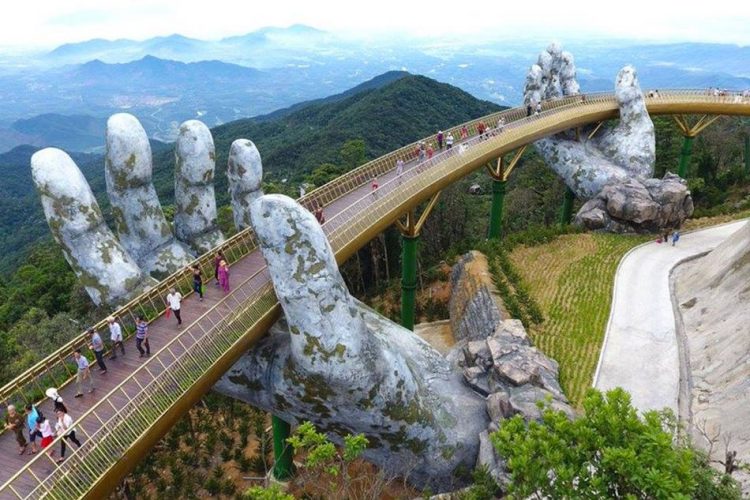The name comes from the word Nam Viet (apologies for not being able to use the correct diacritical marks in the Vietnamese language), which means “Southern Viet” and was in use around the 2nd century BC. The Viet part comes from the name Bach Viet, the people who were living in southern China and Vietnam. The name Vietnam was first seen in a 16th century poem by Sam Trang Trinh. During the 19th century, in an effort to separate the traditional name Bach Viet into its Chinese and Vietnamese counterparts, Vietnam was used to recognize the people on the southern end.
Vietnam lies on the eastern shore of the Indochinese Peninsula. It’s surrounded by China to the north, Laos to the northwest, and Cambodia to the southwest. It’s southern edge has a coast along the Gulf of Thailand and a long eastern coast along the South China Sea. Its narrowest point is only 31 mi across. Most of the land is mountainous, hilly, and covered in forests. The Mekong River Delta in the south is much more populated than some of the other river deltas in the north. There are also a number of coastal islands that dot the coast along the way. The climate can vary depending on which region you’re in. It can be quite hot and humid in the rainforest areas of the south and more temperate the higher in the mountains you go. They do have a rainy and dry season and are affected by the monsoon winds that blow from the northeastern Chinese coast. The country is also affected by tropical storms and typhoons and many of the effects of climate change. But this wide range of climate types help them have a mega biodiversity.
 |
| The Fall of Saigon |
Evidence shows that humans have been living in this area of the world since 500,000 BC and even learned how to cultivate rice around 1000 BC. The Hong Bang Dynasty is often considered the first Vietnamese state, and they were quite connected to Chinese dynasties. In fact the northern part of Vietnam for all intents and purposes was considered part of Chinese territory. They eventually won their independence from under Chinese rule and even warded off Mongol invasions three times. Between the 11th and 18th centuries, Vietnam expanded its territory south. This set things off internally, and there were many civil wars happening across this region for many years. Emperor Nguyen Anh was able to smooth over some of the conflicts (with the help of the French) and reunify them in the 1800s. In the meantime, Europeans have been trading along the Vietnamese coast since the 1500s. Or at least, tried to. The Portuguese were the first to try off and on, and Dutch traders did some trading there too along with the British and Spanish. During the mid-1800s, there were a lot of conflicts between the Vietnamese and the Catholic missionaries who were basically making the Vietnamese upset over their push of Christianity. France stepped in and ended up taking over the lower third of the country, creating a colony called Cochinchina. This brought quite a bit of changes and western influence over this region, including setting up plantation crops in tea, coffee, tobacco, and indigo. However, the continued fighting inspired a few Vietnamese leaders to call for their independence from French rule. It wouldn’t happen yet, and France ruled over it. That is, until the Japanese invaded during WWII and stripped the country of its resources, leaving many Vietnamese to starve to death. The place was a mess after the war, and the Allies divided the country in half; the French still tried to hold rule, but the Viet Minh had other plans (which included guerilla attacks). French Indochina was finally broken into three countries in the 1950s: Vietnam, Cambodia, and Laos. The Vietnam War gets a little complicated, but essentially North Vietnam tried to take over the South’s government. Russia backed the North, and the US (and France) backed the South. It was years of bloody battles, which finally culminated with the Fall of Saigon in April 1975. The two halves eventually reunited, but still dealt with a transitioning government in the midst of other regional conflicts (like the Khmer Rouge). Since the 1980s, Vietnam has made quite a few changes in its policies and socio-political sphere so that some political-economists think that Vietnam may be part of the next group to watch as up-and-coming developing countries.
 |
| Hanoi |
The capital city is Hanoi, the country’s second largest city (after Ho Chi Minh City [formerly Saigon]). Located in the northern part of Vietnam along the Red River Delta, it also served as the capital of French Indochina and then North Vietnam. It’s a city of old buildings highlighting its ancient past mixed with French colonial-style buildings of a more modern European style. Today, the city has several shopping districts, theatres, sporting venues, restaurants, and several universities and colleges.
For most of Vietnam’s history, it was an agricultural-based economy, mainly in rice cultivation. They also did quite a bit of bauxite mining as well (bauxite is a key mineral used in making aluminum). For many years, farms and factories worked as a collective under state control. But the quality and conditions were poor and improperly run, to say the least. Their main trading partner was the Soviet Union, and when they broke up, Vietnam had to change up its plans a bit. They allowed for more private ownership and restructured their economy to fit in with the global market. Their deep poverty rate fell by a ton, and in the early 2000s, they discovered oil. Today, it’s one of the larger oil producers in Asia and has focused on science and tech-based industries (in fact, the creator of the famous Flappy Bird app was a Vietnamese developer). Tourism still plays a driving factor in their economy with millions of people all over the world visiting Vietnam each year.
.jpg/1200px-Thich_Nhat_Hanh_12_(cropped).jpg) |
| Thich Nhat Hanh |
Although their constitution declares that people have the freedom to practice and choose whatever religion they want, the bottom line is that nearly 80-85% of the people don’t really believe in any god or adhere to any religion at all. Of the few who do, about 5% are Buddhist, and the rest are followers of Christianity, native/folk religions, and Islam. This actually surprises me a bit because when I was interested in Buddhism several years ago, I bought a book by the Vietnamese monk Thich Nhat Hahn. One statement he made was that someone once asked him if he was from North Vietnam or South Vietnam, and his answer was “The middle.” (I thought it was metaphorical, but he was born in Hue, which is actually, almost right in the middle.)
Not surprising, the national language is Vietnamese. It’s a tonal language in the Mon-Khmer language group. Because of its close ties to China, early Vietnamese used Chinese characters. But after the Portuguese Jesuits arrived, they romanized their writing system and used sets of diacritical marks to indicate the different tones. The French language is still spoken by many of the highly educated Vietnamese as a second language, and many of the older generation can still speak some French as well (Vietnam is still included in the Francophonie countries). Some areas and families who had ties to the Eastern Bloc countries still utilize languages like Russian, Polish, German, and Czech. Today, English, Japanese, and Korean are popular second languages, especially in terms of strengthening global ties.
 |
| One of the coolest bridges I've seen is in Vietnam! |
Years ago, I went to take a part-time job grading standardized tests. I actually really liked that job. In my little group, there was a woman whose last name was Nguyen (pronounced something like “wen”). But I looked at her, and she was as pale as I was with red hair. We got to talking, and her husband was Vietnamese. She told me that after they got married, they flew to Vietnam to visit his parents and family who were still there. Naturally, I asked what she thought. The first words that came out of her mouth were, “I hated it.” I stared at her in disbelief. She corrected herself a bit: “It’s a beautiful country, it really is. But it’s also soooooooooo humid, and I just don’t do well in high humidity. So, I was basically miserable the entire time.” So, there’s also that, haha.
Up next: art and literature




No comments:
Post a Comment